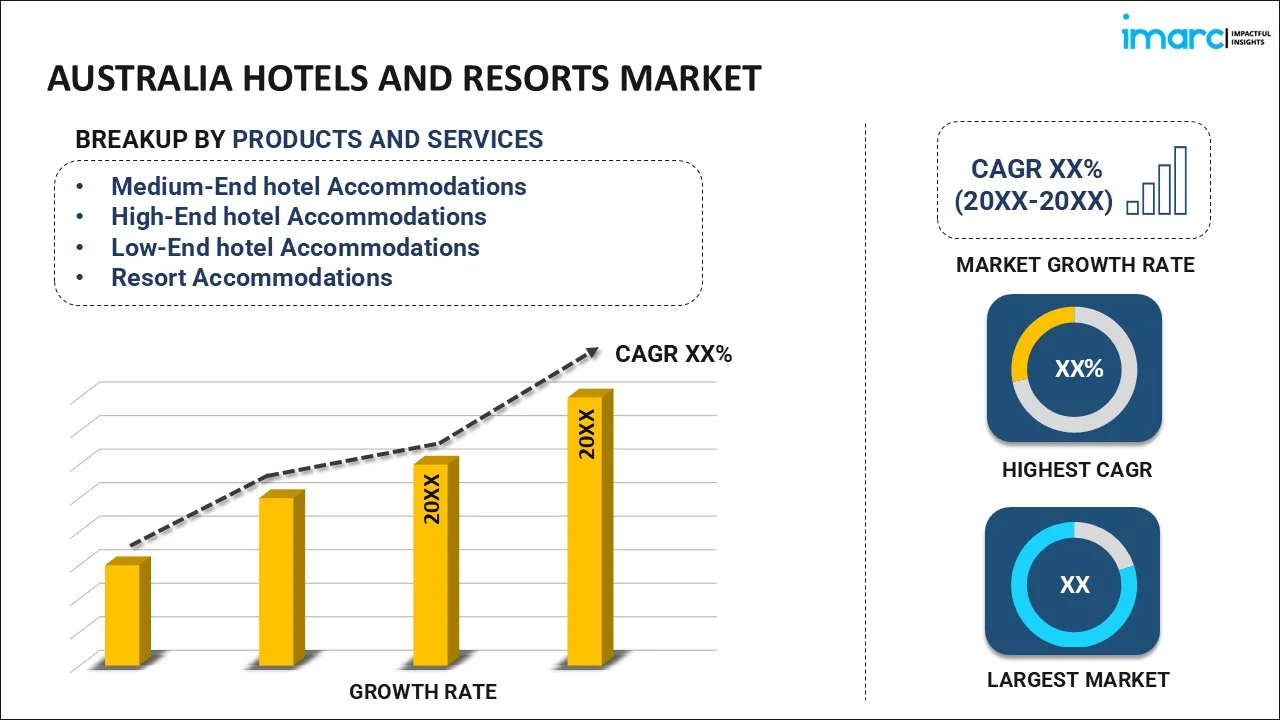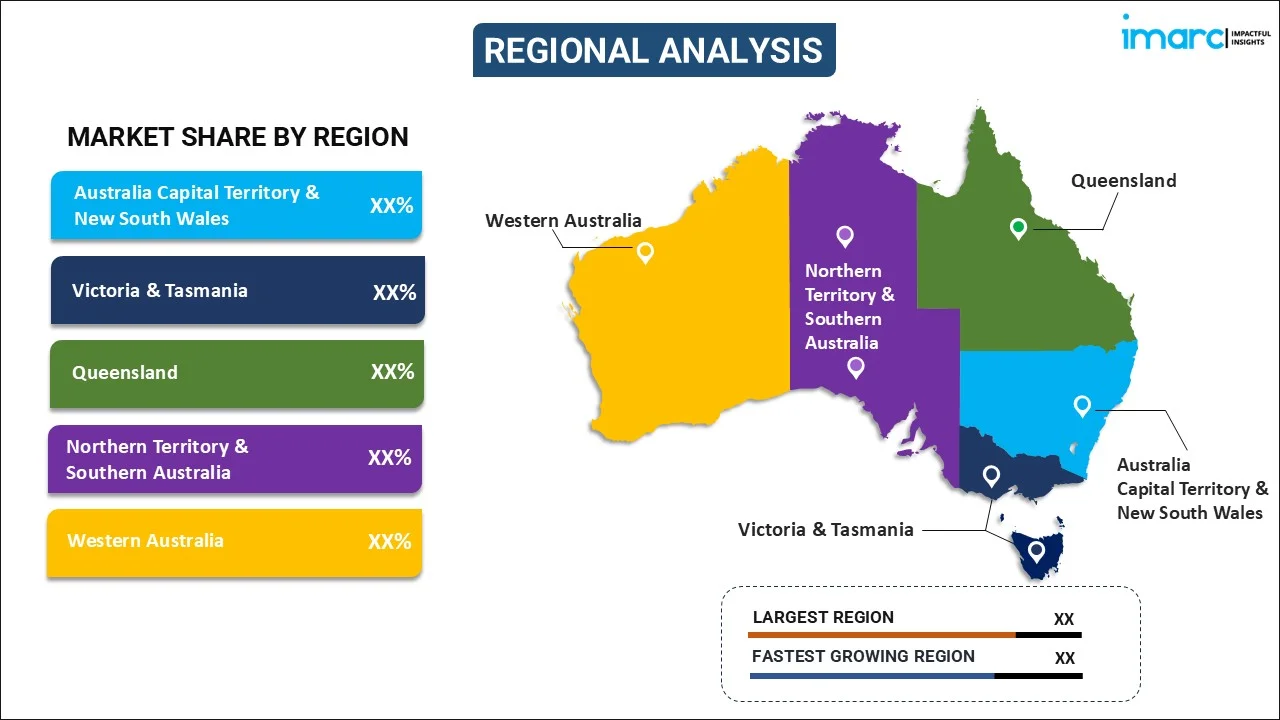
Australia Hotels and Resorts Market Size, Share, Trends, and Forecast by Products and Services and Region, 2025-2033
Australia Hotels and Resorts Market Overview:
The Australia hotels and resorts market size reached USD 31.40 Billion in 2024. Looking forward, IMARC Group expects the market to reach USD 82.80 Billion by 2033, exhibiting a growth rate (CAGR) of 11.40% during 2025-2033. The market is steadily growing, driven by rising domestic and international tourism with increased investments in luxury and eco-friendly accommodations, and the integration of advanced digital technologies to enhance guest experiences and operational efficiency.
|
Report Attribute
|
Key Statistics
|
|---|---|
|
Base Year
|
2024 |
|
Forecast Years
|
2025-2033
|
|
Historical Years
|
2019-2024
|
| Market Size in 2024 | USD 31.40 Billion |
| Market Forecast in 2033 | USD 82.80 Billion |
| Market Growth Rate (2025-2033) | 11.40% |
Australia Hotels and Resorts Market Trends:
Rising Popularity of Eco-Friendly and Sustainable Tourism
The Australia hotels and resorts market is undergoing a significant transformation, aligning with the growing demand for eco-friendly and sustainable tourism. Travelers are prioritizing accommodations that uphold their values, particularly focusing on environmental sustainability to minimize their ecological footprint during their journeys. Hotels are highly adopting such sustainability ventures, such as energy-saving systems, waste minimizing programs, and renewable sources of energy. Eco-friendly architecture, water-conserving technologies, responsible sourcing of materials and food products which are standard in various establishments. This trend is driven by the inclination of hotels to comply with regulations to attract a growing number of environmentally aware travelers. For instance, in September 2024, Accor, a major hotel operator in Australia, announced the recipient of Sustainable Tourism Certification by Ecotourism Australia for its 100th hotel. This achievement will aid Accor in attaining its objective of having 100% of its network in Pacific region receive certification for sustainability by 2025 end. Moreover, Australian landscape, with its natural wonders, encourages eco-tourism and nature-centric experiences. Hotels incorporating these features into their operations, including providing eco-tours, supporting conservation efforts, and are collaborating with local communities to create unique, sustainable experiences for guests. This strengthens the appeal of the market and attracts ecotourism-minded travelers who place a premium on environmental responsibility during their visits.
Growing Demand for Experiential and Luxury Travel
The Australia hotel and resort industry is witnessing a surge in demand for experiential and luxury travel, prompting a shift towards accommodations that offer unique and immersive experiences for affluent tourists. This also includes activities, such as guided tours, culinary experiences, wellness and spa services, and cultural immersion programs. The "experience over product" trend is driving hotels and resorts to transition from traditional setups toward curated packages that prioritize memorable experiences tailored to guests with preferences and desires. Luxury travel growth is fueled by high premium room inventory in gateway destinations like Sydney, Melbourne, and the Gold Coast-the latter an essentially tropical destination with world-class attractions and cityscapes. The Great Barrier Reef and the Outback, tap into this trend by adding private island tours, snorkeling adventures, and customized nature walks to their resorts in natural destinations. Apart from this, the demand for luxury and experiential stays promotes investments in upscale properties and amenities, which are amplifying market competition. For instance, as per industry reports, luxury travel is notably rising across Asia Pacific, with travelers planning for longer holders. In line with this, Australia has emerged as a preferable destination, with 46% people visiting the nation.
Australia Hotels and Resorts Market Segmentation:
IMARC Group provides an analysis of the key trends in each segment of the market, along with forecasts at the country level for 2025-2033. Our report has categorized the market based on products and services.
Products and Services Insights:

- Medium-End hotel Accommodations
- High-End hotel Accommodations
- Low-End hotel Accommodations
- Resort Accommodations
The report has provided a detailed breakup and analysis of the market based on the products and services. This includes medium-end hotel accommodations, high-end hotel accommodations, low-end hotel accommodations, and resort accommodations.
Regional Insights:

- Australia Capital Territory & New South Wales
- Victoria & Tasmania
- Queensland
- Northern Territory & Southern Australia
- Western Australia
The report has also provided a comprehensive analysis of all the major regional markets, which include Australia Capital Territory & New South Wales, Victoria & Tasmania, Queensland, Northern Territory & Southern Australia, and Western Australia.
Competitive Landscape:
The market research report has also provided a comprehensive analysis of the competitive landscape. Competitive analysis such as market structure, key player positioning, top winning strategies, competitive dashboard, and company evaluation quadrant has been covered in the report. Also, detailed profiles of all major companies have been provided.
Australia Hotels and resorts Market News:
- In August 2024, the Marriot group announced the introduction of the Adelaide Hotel, a seamless blend of heritage architecture with modern interiors. The 16-floor property offers 285 spacious rooms, luxury amenities like an 18-meter indoor pool, a fitness studio, and executive dining, all within walking distance of Adelaide’s top attractions.
- In November 2024, IHG Hotels & Resorts, in collaboration with Felix Capital, announced the debut of voco Maroochydore Sunshine Coast in 2028. Located on Ocean Street, the 153-room hotel will feature a pool, spa, restaurant, event spaces, and luxury residences, supporting regional growth ahead of the Brisbane 2032 Olympics.
Australia Hotels and Resorts Market Report Coverage:
| Report Features | Details |
|---|---|
| Base Year of the Analysis | 2024 |
| Historical Period | 2019-2024 |
| Forecast Period | 2025-2033 |
| Units | Billion USD |
| Scope of the Report |
Exploration of Historical Trends and Market Outlook, Industry Catalysts and Challenges, Segment-Wise Historical and Future Market Assessment:
|
| Products and Services Covered | Medium-End Hotel Accommodations, High-End Hotel Accommodations, Low-End Hotel Accommodations, and Resort Accommodations |
| Regions Covered | Australia Capital Territory & New South Wales, Victoria & Tasmania, Queensland, Northern Territory & Southern Australia, Western Australia |
| Customization Scope | 10% Free Customization |
| Post-Sale Analyst Support | 10-12 Weeks |
| Delivery Format | PDF and Excel through Email (We can also provide the editable version of the report in PPT/Word format on special request) |
Key Questions Answered in This Report:
- How has the Australia hotels and resorts market performed so far and how will it perform in the coming years?
- What is the breakup of the Australia hotels and resorts market on the basis of products and services?
- What is the breakup of the Australia hotels and resorts market on the basis of region?
- What are the various stages in the value chain of the Australia hotels and resorts market?
- What are the key driving factors and challenges in the Australia hotels and resorts market?
- What is the structure of the Australia hotels and resorts market and who are the key players?
- What is the degree of competition in the Australia hotels and resorts market?
Key Benefits for Stakeholders:
- IMARC’s industry report offers a comprehensive quantitative analysis of various market segments, historical and current market trends, market forecasts, and dynamics of the Australia hotels and resorts market from 2019-2033.
- The research report provides the latest information on the market drivers, challenges, and opportunities in the Australia hotels and resorts market.
- Porter's five forces analysis assist stakeholders in assessing the impact of new entrants, competitive rivalry, supplier power, buyer power, and the threat of substitution. It helps stakeholders to analyze the level of competition within the Australia hotels and resorts industry and its attractiveness.
- Competitive landscape allows stakeholders to understand their competitive environment and provides an insight into the current positions of key players in the market.
Need more help?
- Speak to our experienced analysts for insights on the current market scenarios.
- Include additional segments and countries to customize the report as per your requirement.
- Gain an unparalleled competitive advantage in your domain by understanding how to utilize the report and positively impacting your operations and revenue.
- For further assistance, please connect with our analysts.
 Inquire Before Buying
Inquire Before Buying
 Speak to an Analyst
Speak to an Analyst
 Request Brochure
Request Brochure
 Request Customization
Request Customization




.webp)




.webp)












